At my last Chinese language class in Yangshuo, a guy recommended a language school in Dali and also said it was a great place to spend some time. I had last been in Dali 32 years previously, so I decided to give it a try.
It was a long journey, since after changing flights and arriving in Kunming, I had to get to the train station. Young people at two different information desks had no idea how to get there, but they called someone and finally were able to direct me to a bus. I asked a man sitting next to me on the bus if it was really going to the train station, and he tried feverishly to find out on his cellphone. A couple of times he said that I would have to take a taxi before finally discovering that the bus would stop at the train station.
I had some difficulty walking around construction to find the entrance and then tried to find the counter where I was to pick up my reserved ticket. There was no such sign at any counter and no information desk. Some women working at the station finally directed me to an entrance where I had to show my passport and was told that I did not have to pick up my ticket, contrary to instructions in the internet. I found the entrance to the track from where the train was leaving and was told to wait. The gates opened 15 minutes before departure, and when I showed my ticket voucher, the woman had the gate did not want to see that, only my passport again. When I took a train back to Kunming a couple of weeks later, again nobody wanted to see my ticket, only my passport.
Down at the track, I was finally directed to a line where my car with my reserved seat would be. I had wanted to train an express train in China for a while and was curious as to how fast it would go, but the highest speed was 199 km/hour. Still, the ride only took two hours, which reduced the previous slow train time by 4 ½ hours, not to mention the 10-12 hours on a bus that we had needed long ago.
In Dali, I showed a taxi driver the address of the language school I was going to attend and off we went. The train station is in a new section of the city, which did not exist a few years previously and if replete with modern high rises and wide avenues: quite a shock considering that it was a sleepy mountain village last time I was there.
It was a long 40-minute drive, and the taxi driver had trouble finding the school. Fortunately, I had the phone number of a teacher at the school, whom he called and finally found the place with her directions. The school’s homepage had stated that it was in the old town of Dali, but that was an exaggeration, since it is several kilometers away from it. Instead, it is in the middle of nowhere with nothing much in the vicinity. I had reserved a room in the school and expected there would be other students living there, but I was the only one: for a good reason! The room did not have a desk or chair, no hot water in the bathroom and a poor internet connection. The teacher told me that the other students stay in the old town and only came for classes, since that is where all the restaurants, cafes and bars are.
The next day, the teacher took me on a short tour of the old town, and I said that I wanted to stay there too. We both looked for hotels on the internet, but she said it would be better to wait until the next day and talk to other students about where a good place to stay was. Fortunately, I did not do that, especially since there were only two other students the next day and they only came for one hour.
I found a hotel that looked good on the internet, but the teacher said it was very expensive on the website where she found the same one. It was half the price on mine. I convinced her that I wanted to take a look there, and reluctantly she found the way there. It turned out to be a great deal and I got a beautiful room in the architectural style of the local Bai ethnic group. There was a bus stop nearby that ran almost every five minutes took me to the school in ten.
I was told that the school had approx. 20 students two years previously, but then was suddenly not able to get visas for its students. Most then left, although there is another “language school” in town with quite a few students, since it can get visas for its students, is cheaper and does not require students to show up, since most of them only want the visa so they can work teaching English. But then this is what my teacher told me, so I am not sure whether it is true. I almost never saw other students at the school, and the ones who came were mostly for only an hour or two each week. Other language schools that I had attended in China gave you a folder on the first day with information about the place, a map, recommendations for restaurants and excursions. This school had no such material. I preferred a different teacher in the morning and afternoon, but this was not possible since there were only two teachers the first week (a third one showed up the second week for a foreigner who came for five weeks of intensive classes). In addition, there was no teaching material for my level, so I had to suggest it myself.
The school had photos on the wall of its eight teachers, but only two were still there when I arrived, one also working part-time as secretary. The owner was in Ethiopia doing business, one of the approx. million Chinese in Africa (cf. the book “China’s Second Continent: How a Million Migrants Are Building a New Empire in Africa by” by Howard French for a great description of that), and rarely returns to Yunnan where she has three languages schools (besides Dali, in Kunming and Lijiang), and there are apparently lots of students in the other two.
I was confused at first as to why the old town did not especially appeal to me, although its expansive pedestrian zone is very nice, constructed like an ancient town with streets in nice stonework and the buildings in ancient design, all very clean and orderly. It is a big contrast to other small tourist town destinations such as Yangshuo (where I studied several times) where the buildings are extremely ugly and many just concrete blocks, except for the new, modern shopping mall there in the center of town.
After a while, I realized the reason: the old town of Dali is like a beautifully designed shopping mall, although I suspect that many shop owners live behind their stores or on a second floor. It’s not a town where people live, but a Disneyland-like replication of an ancient town, although this changes quickly once you leave the pedestrian zone. The streets are pedestrian zones and lined with one souvenir store after another, interspersed with cafes and restaurants. Almost the only people from the Bai ethnic group still wearing their traditional dress were those working in stores or restaurants. My teacher told me that her family and most others moved away from the old town and rent their property to stores and restaurants.
Street scenes in the old town:

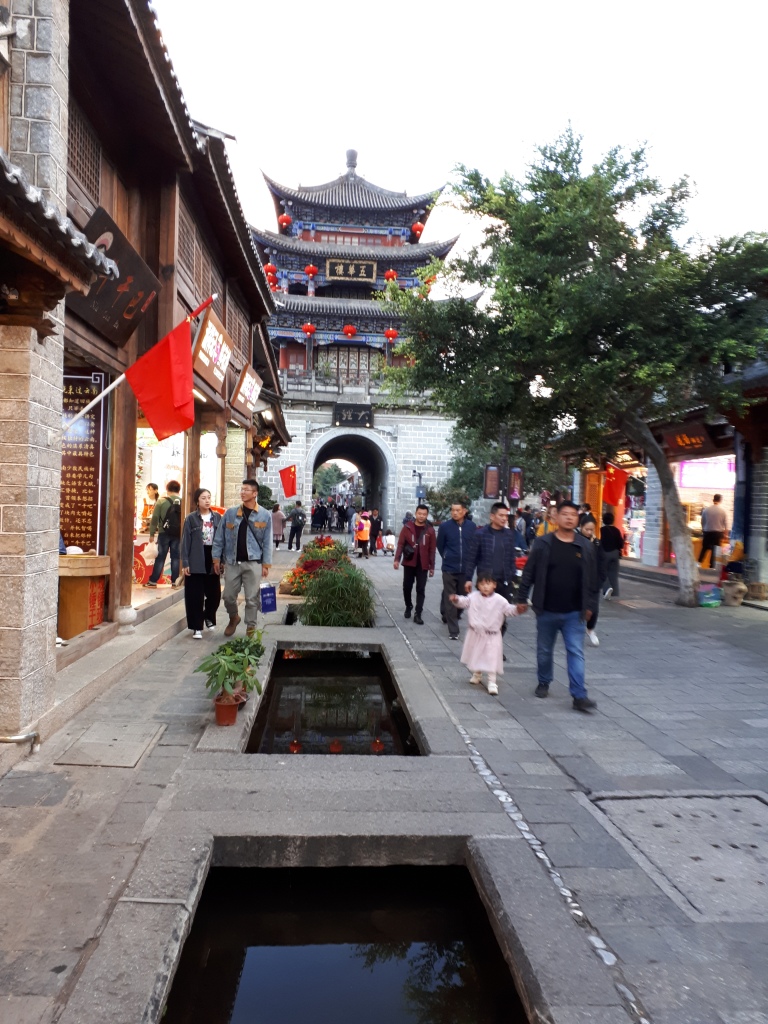


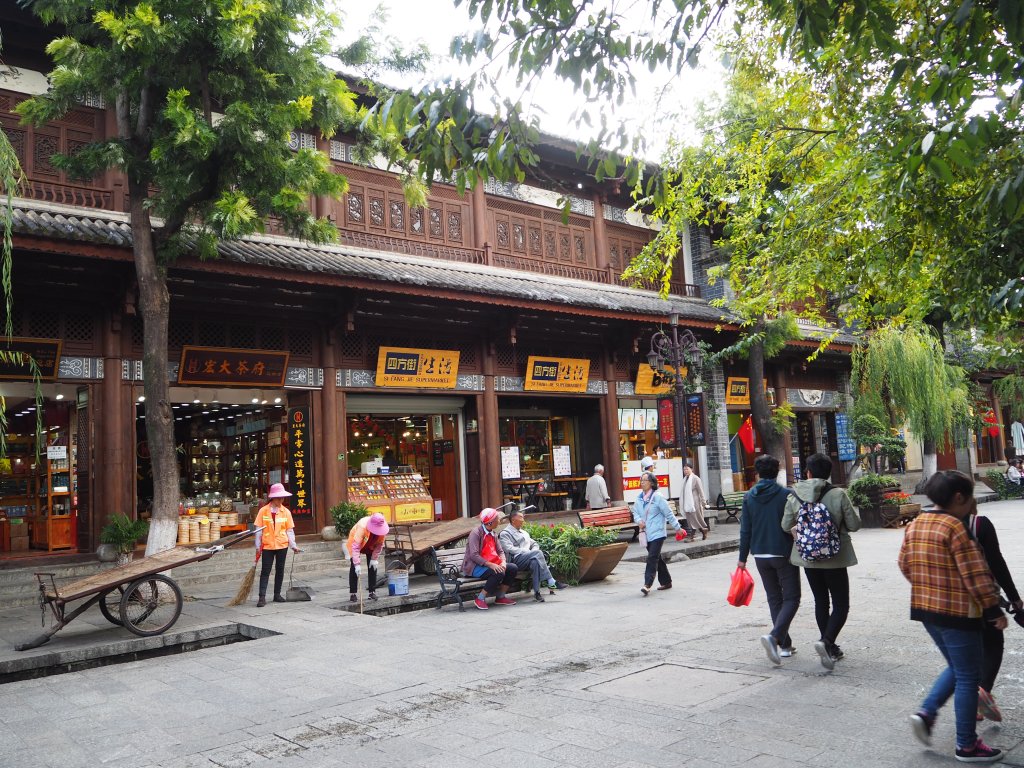
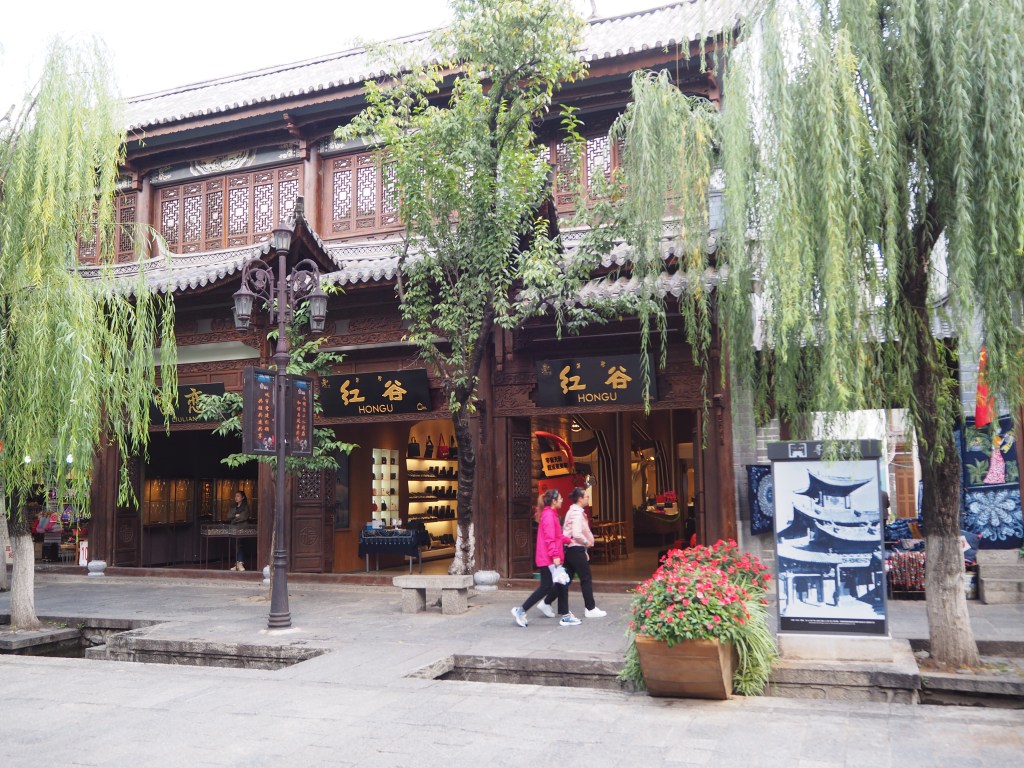

Then

and now:
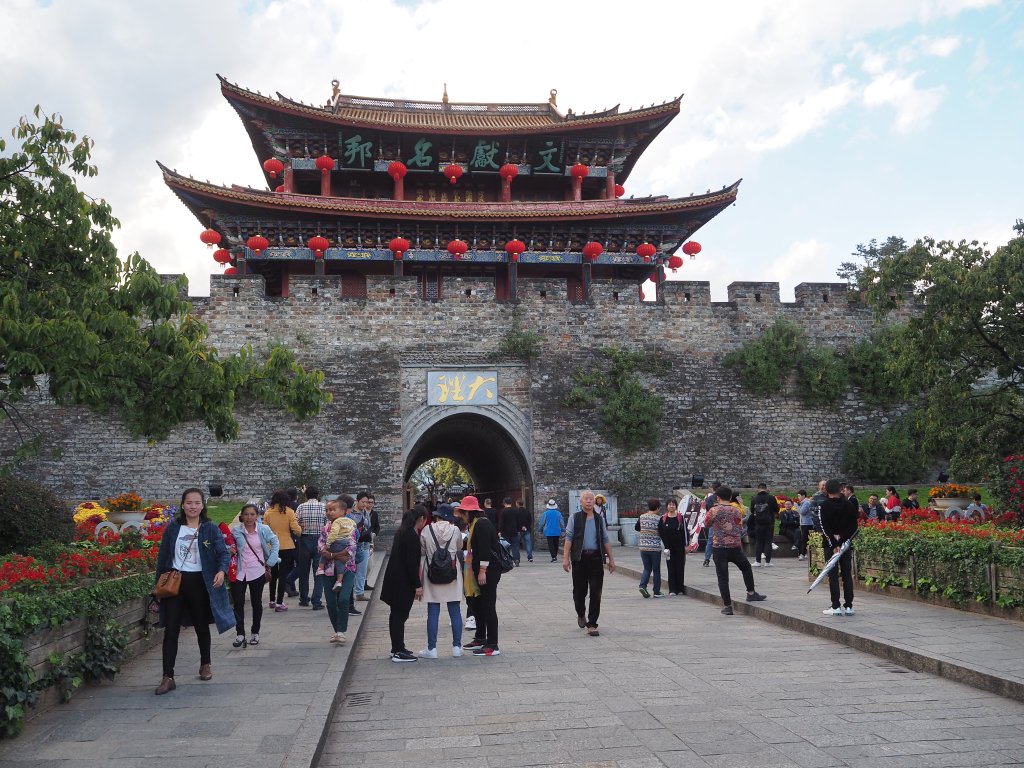



However, once you leave the pedestrian zone of the old town, you enter an area where people live and stores are aimed at locals with unaesthetically constructed buildings.

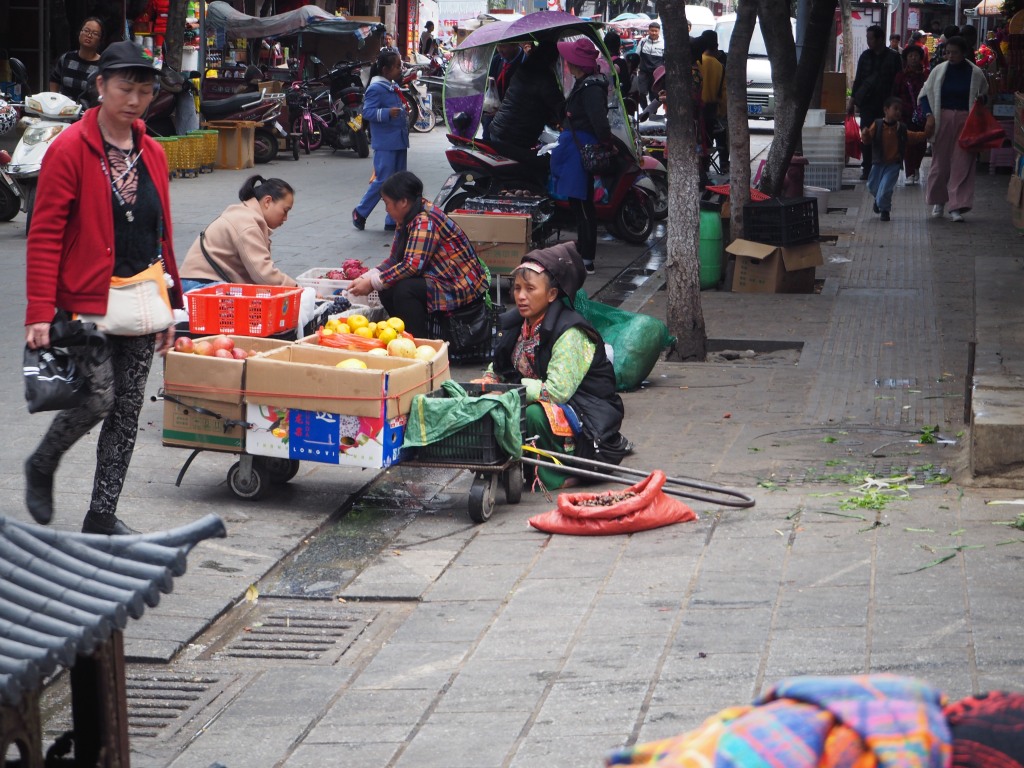

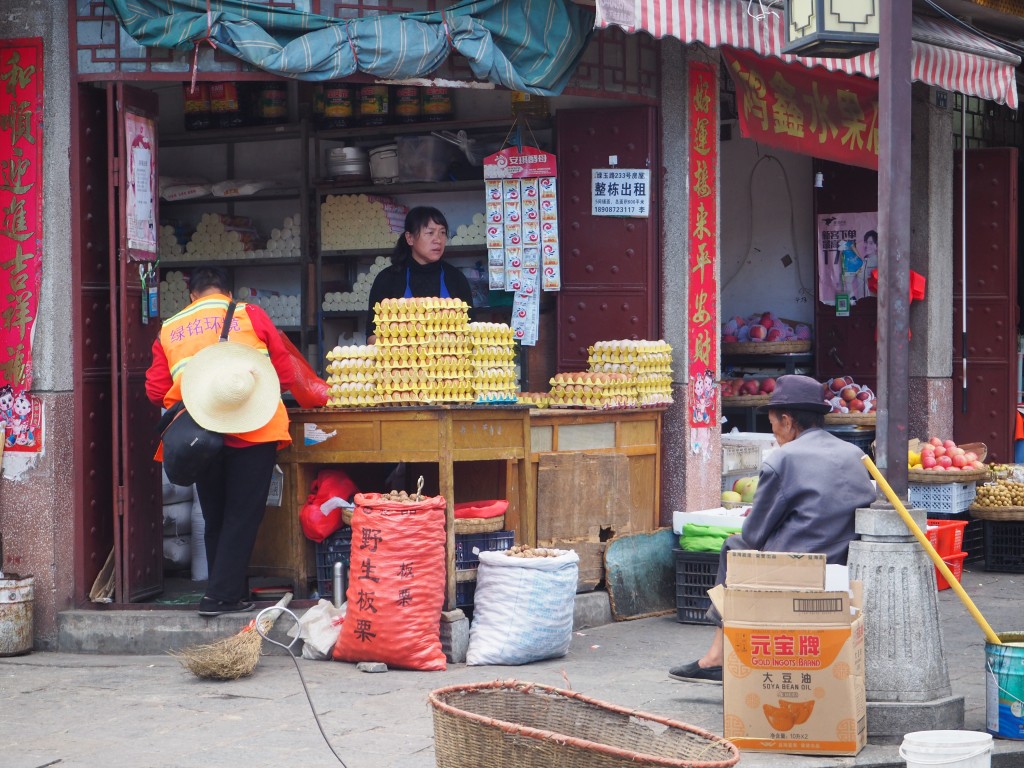

Some places had rather unusual signs:


Wonder what when on in this place and what the elephant had to do with it.

Do they accompany you to get drunk here?
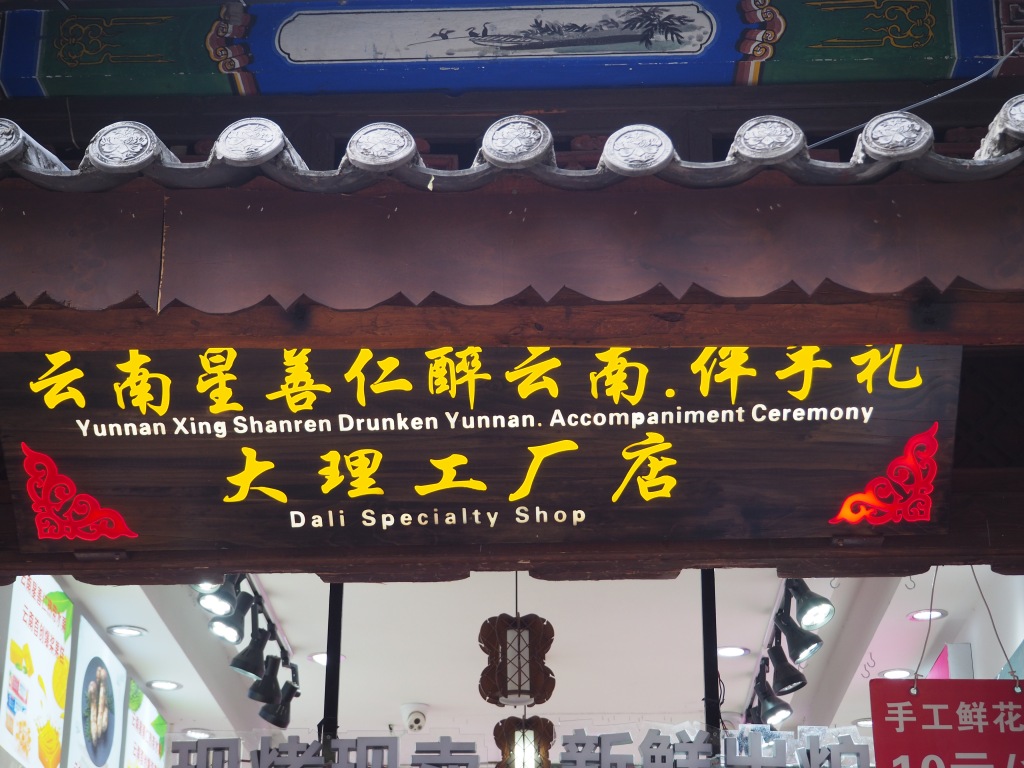
Shao bing (烧饼), flat bread available with various stuffings: on the right, there is an oven similar to a tandoor one, and the friendly owner and cook slapped the bread against the wall of the oven to bake it. Really tasty!

Numerous restaurants offered “Over the Bridge Noodles”. A box is served with various ingredients, which you then add to a bowl of broth and noodles. Most Chinese didn’t seem to eat the broth, but don’t ask me why.


There is a large group of women from the Bai ethnic group who dance on a large square every evening in the old town. I thought that the government was paying them to entertain the tourists, but my teacher told me that they just do this because they enjoy it. None of the women looked to be younger than 50, and the exercise is certainly good for their health.


A Confucian temple has also been constructed in the old town, and I was surprised to see people praying there, since Confucius is not considered a god nor is Confucianism a religion.



The Master Himself


Fellow Travelers

The Three Pagodas then and now as an example of change: you have to pay a hefty entry fee now, while years ago you could just walk up to them, there were no tour buses and almost no tourists.
Then

and now

The next big tourist destination Lijiang two hours by train north is supposed to be even more beautiful (but artificial), but you have to pay to get into the old town where there are so many tourists that you can barely move in the streets.
I was finally starting to get over jet lag, so I went out at 10 p.m. around the corner to the Bad Monkey Bar. I hadn’t realized that it was Halloween, and there was a wild party going on with a great band composed of musicians from Thailand. They could play almost any rock song from Queen to Talking Heads to the Eagles. Strange to see how Halloween, originally a Celtic festival, has spread these past years in its US American version, no longer solely children trick and treating, but adults partying in costumes. The Pope who tried to get rid of it (around 1850 I believe), saying that it wasn’t goblins, elves, etc. who came out that night but instead saints, i.e., All Saints’ Day, had not reckoned with the power of modern marketing.


The hotel owner, Xiao Yang, was very friendly and invited me to have lunch with him, which the woman working in his place prepared. He then invited me to eat lunch with them every day; that was the end of my diet with a lunch of only yogurt. The food was delicious each day, and I was then disappointed in the evenings when I went to restaurants and the food was not half as good. He also lent me one of his guitars and played classical guitar fairly well himself.
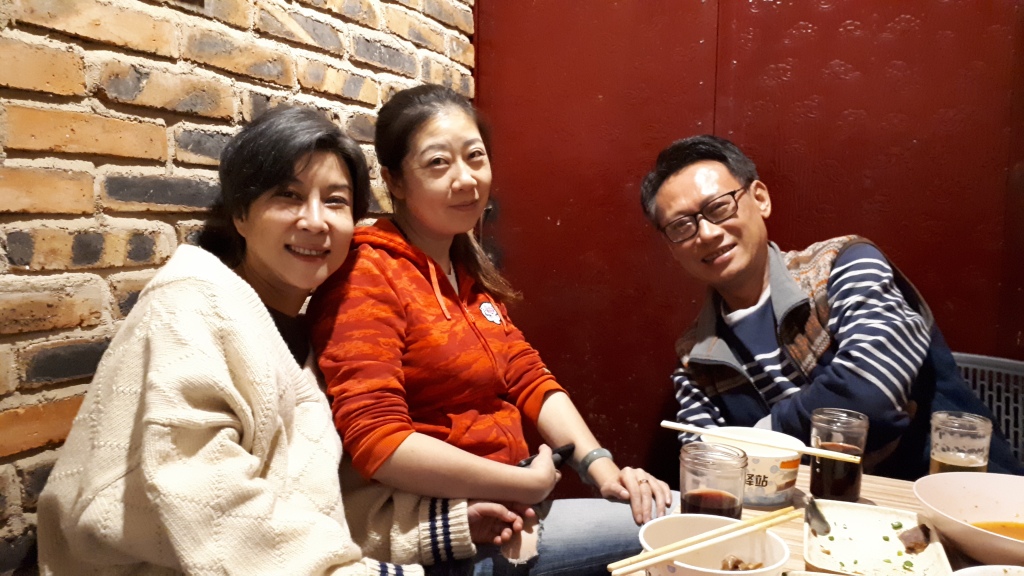
Xiao Yang’s sister showed up to stay in Dali for three months, and he invited us and another friend out for a drink at a hole-in-the-wall Chinese bar. It was a nice, cozy place with no loud music, and it was great to have such an opportunity to talk with them all evening, although I didn’t understand many of the things they said. We went out together a few times for dinner or just drinks, and it was great language practice for me in addition to getting to know some Chinese. I realized that I would never become really fluent without living in China for a longer time (which I do not want to do). Still, I am very grateful for their friendship and lucky to have had such nice contact to people here although I only stayed for a short time.

Delicious lunch every day.

I invited them to a Korean restaurant, and Xiao Yang said it was the first time that a foreigner had invited him out to dinner.
He previously had a hotel down near the lake, but the government had razed all buildings there to protect the lake’s environment and forbid fishing. Swimming is also forbidden due the lake’s pollution but also because of strong currents or whirlpools. There are few boats on the lake, and my teacher told me that sailboats are prohibited, because you could fall off and drown, perhaps due to the whirlpools. The many fish traps that I had seen being sold at an outdoor market years before are only used as lamp shades these days.
Fish traps sold many years ago:
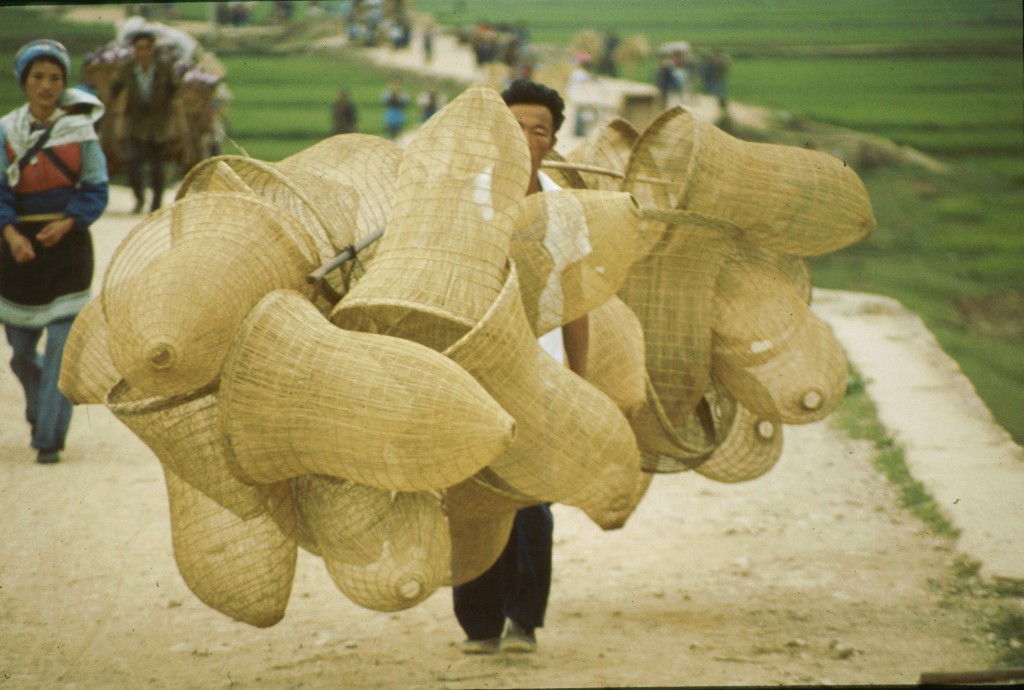
Fish traps as lampshades today:

There are lots of bars where usually one lonely Chinese guitarist strums a few tunes and sings Chinese pop, rock and/or folk music. I really saw any people patronizing these bars, which were otherwise often empty. Perhaps I wasn’t out late enough.
Street lined with bars:

There are apparently somewhat more than 1,000 foreigners living in Dali, and many are there for the great weather: never very cold or hot. I didn’t see many, but was told that a lot of them all stay in one hotel run by another foreigner. Near the end of my stay, I met a Canadian who took me to the hotel, since it has its own VPN that almost always works. The rooms there are certainly nice and a lot quieter than where I stayed. There is also a big lounge with a bar and pool table. I imagine it might be more comfortable to stay there, but then there would be the temptation to talk a lot with other foreigners and little chance to practice Chinese as I did with my hotel owner, his sister and friends.
Foreigners who have been in Dali for a long time usually rent a room or apartment, and it certainly a lot cheaper than staying in a hotel. Still, I met a couple of foreigners who did such and said they had one or no Chinese friends, and I wondered why they were there at all except for the weather.
Many musicians, artists and other Chinese from Beijing have moved to Dali to escape the pollution and for the weather. Most certainly cannot earn as much money as in the capital, but it is nice to see that there are Chinese who value quality of life more than riches.
There are some great hiking paths in the adjacent Cang Mountains (“cang” translates as dark green or blue; many foreign websites refer to “Cangshan Mountain”, but “shan” already means “mountain”) with cable car access up. The mountains are at the southern tip of the Tibetan plateau. I took the Xi Ma Tan cable. It is the longest (in China) and takes you to 3,900 m. Malong Peak is the highest spot at 4,122 meters. Dali itself lies at 1,975 meters, and I made the mistake of walking up approx. 600 meters to where the cable car starts; it would have been a lot nicer to do that walking on mountain paths! Overall, the cable car goes up 1,648 meters with one change midway. Some foreigners prefer to save money (it is not cheap) or need a great challenge and walk up and down, but that seemed more like a chore than fun to me. I did not think I would have enjoyed such a long hike up: 1,000 meters okay, but not more. Women were selling oxygen at the start of the cable car climb, and I did not realize how high we were going, since I had no guide book (Lonely Planets having become rather useless these past years, catering to all travelers instead of backpackers as in its beginnings; in some backpacker hotels, you can see sundry tourists perusing the same guide books and reading about the same insider tips, which are already more than well known) and had thought that I would meet other foreigners at the language school who would give me tips about places in and around Dali. It was really cold at the top, for which I was not prepared either, but still the views were fantastic.



View of Cang Mountain from the bus stop where I took a bus to school each day. The weather was beautiful every day!
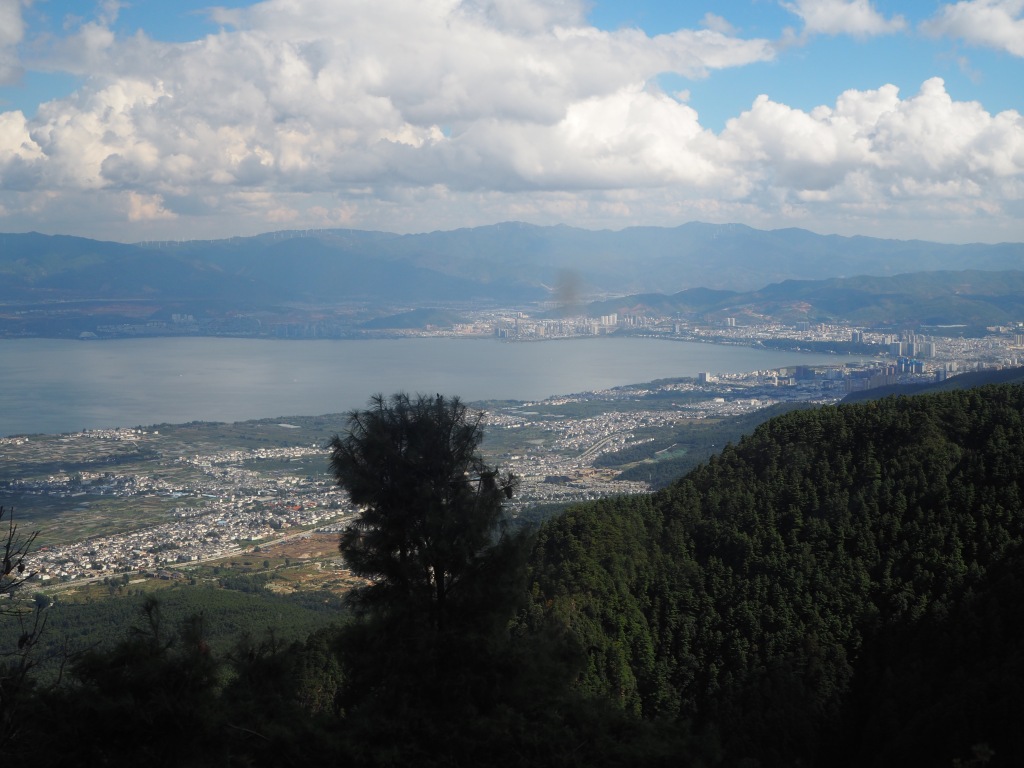



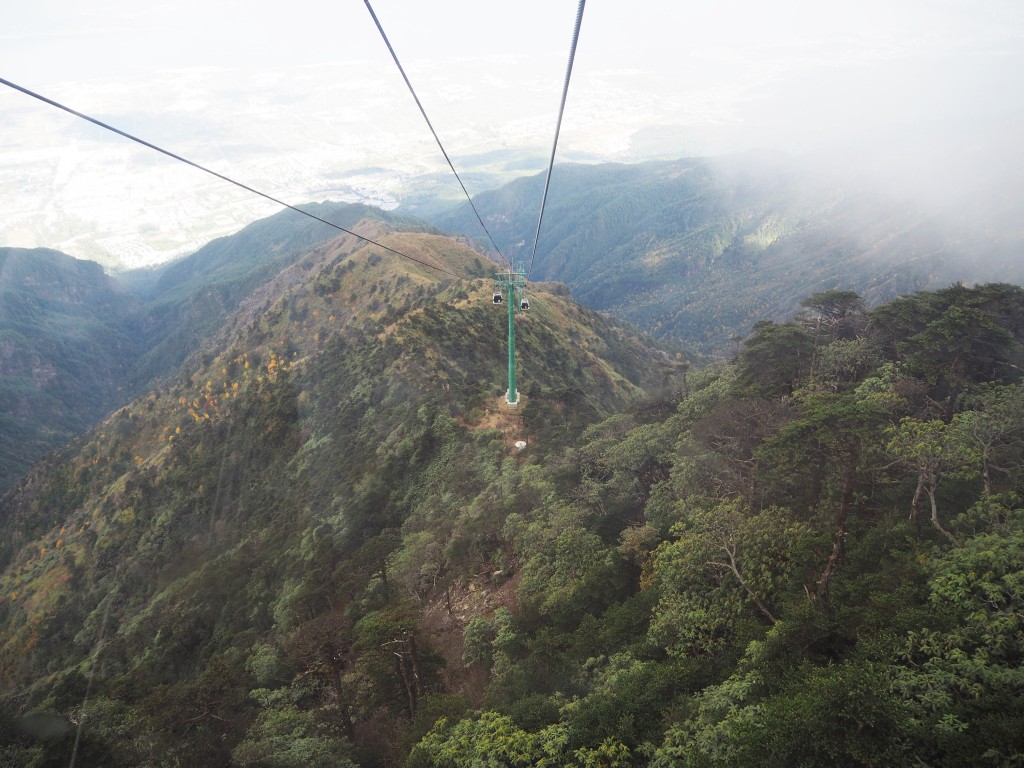
You have to pass through the TianLongBaBu movie studio to exit the park, and there was some silly performance when I walked through.


The guy with the glasses was from the audience, who caught a bouquet that the “princess” threw out and consequently was dragged in to play the part of the groom.
I didn’t stay long, since I planned a hike the next day and wanted to go to the opening of an art exhibition in the Dali Art Factory. The paintings were not my style, done by an Austrian woman living Dali for three months and who was leaving a couple of days later. There was an interesting Daoist ceremony, I guess to ward off evil and bring success to the exhibition or maybe just for entertainment. The Art Factory is quite an interesting place with different artists exhibiting their wares and a climbing wall (not sure why that is in an art exhibition center).

I thought he was a monk at first, but he came out later with a glass of wine in his hand and said he was not.
I rode the ZhongHe chairlift the next day, which takes approx. 25 minutes to ZhongHe Temple at 2,600 m. You see a lot of tombs below as you go up, perfect burial site with mountain behind and facing water (perfect fengshui location). I first headed north and hardly saw anyone for most of this part. The first 2.5 km provide spectacular views of Erhai Lake and the surrounding area as well as of the mountains. I just wondered why there were almost no boats on this huge lake (250 sq. km), although fishing in it is apparently important. The trail is paved stone, probably due to the heavy rainfall in some seasons, but that certainly wore on my feet after a while. The next 2 km the trail is no longer without such pavement, but there are flat stones all along the way and I was mostly in forest without the views. Back and 2 km in the other direction, one place with good views but otherwise also a forest trail.






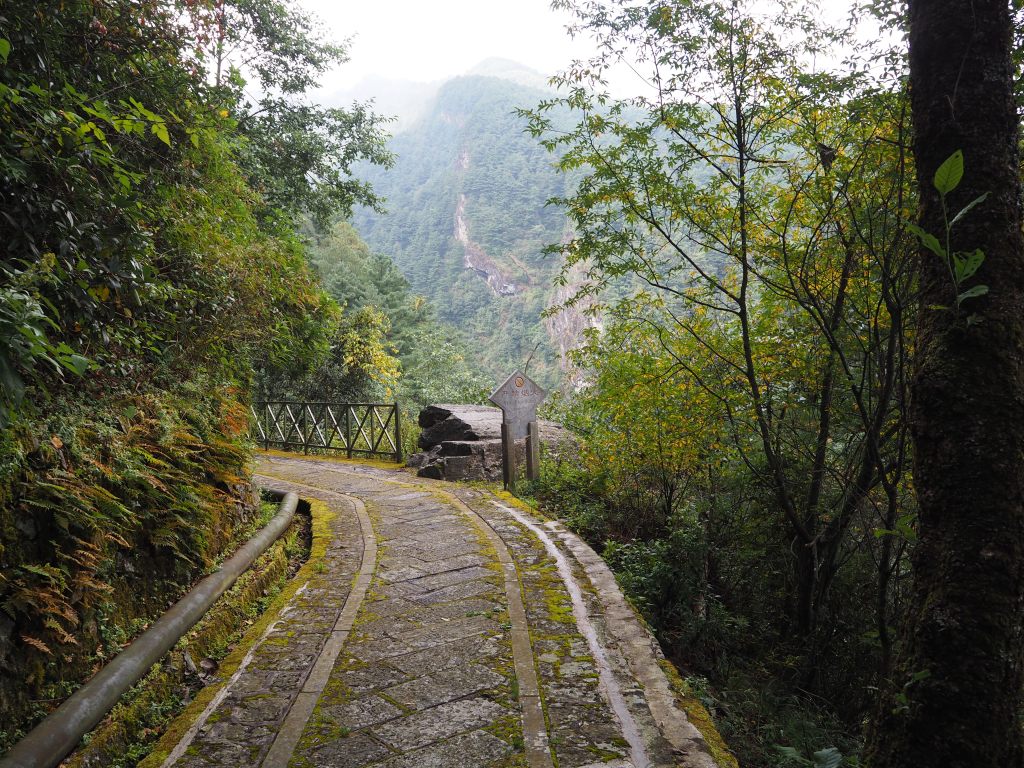


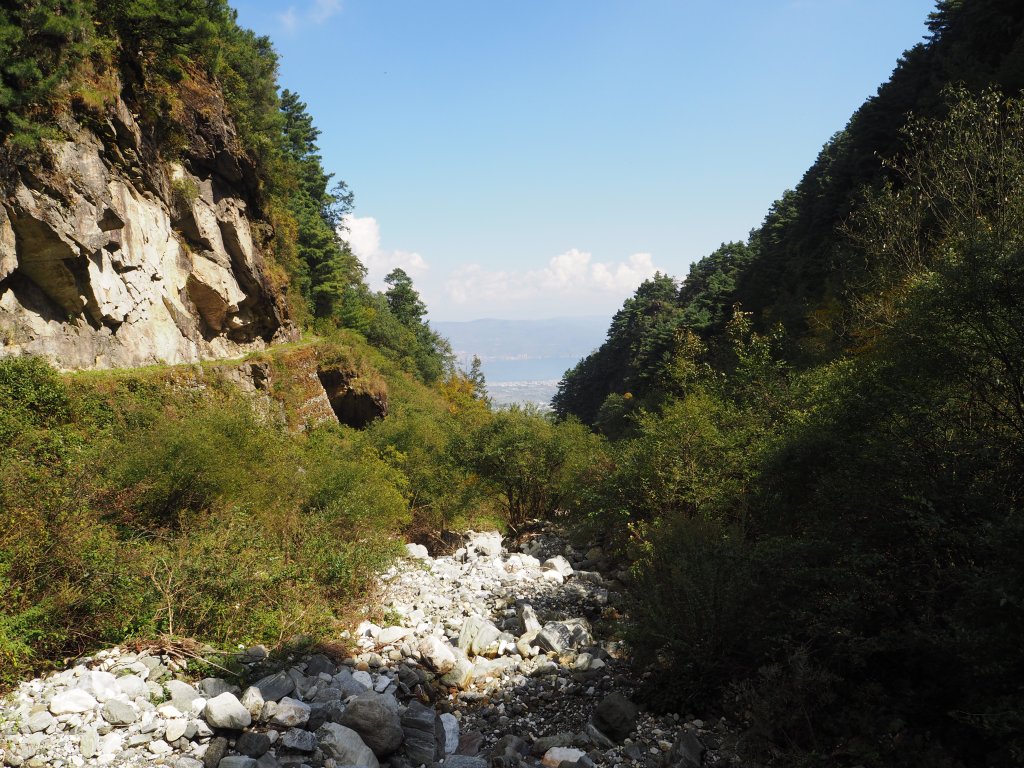

Northernmost point of the trail where there is a dirt road down.


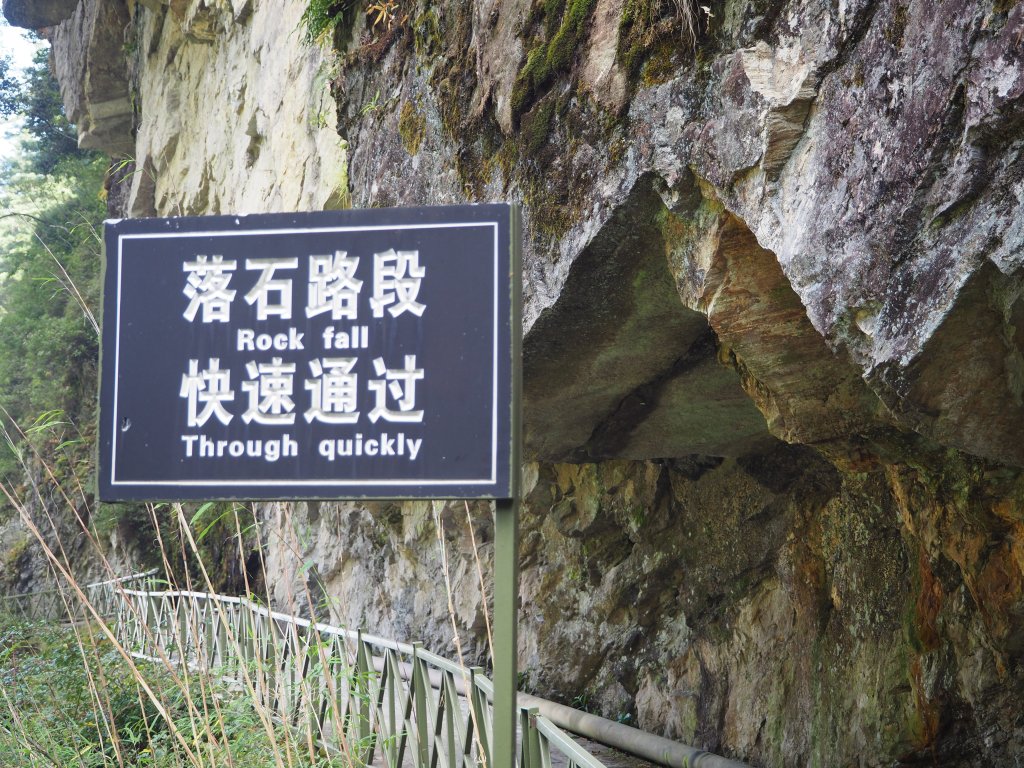
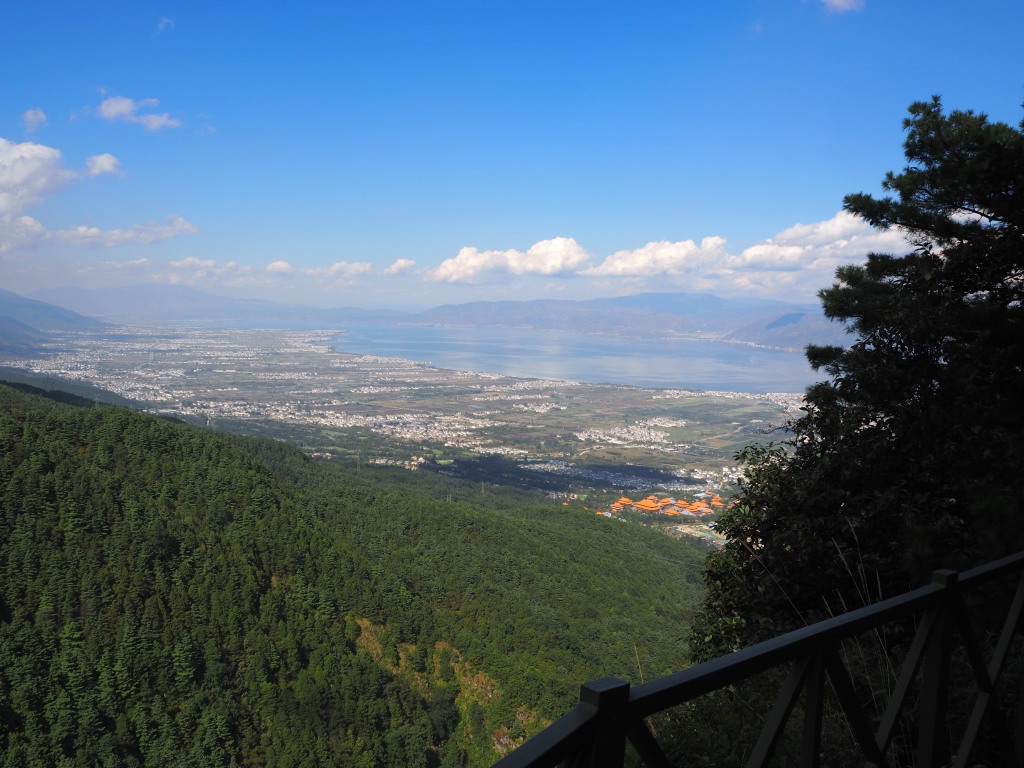
Spectacular views!
The trail was line with signs prohibiting smoking (which no everyone observed) or fires, littering, etc. as well as warnings about falling rocks. This one really struck me:

My translation: “The area ahead is the Cang Mountain area, where more than a hundred people have disappeared and died over the past decade. Of these incidents, an average or more than 15 occurred each year. To ensure the safety of your life and property, no one is allowed to enter (i.e., “leave the designated trail”)! If the offender is to be punished under the Cang Mountain Protection Management Ordinance, the person who damages a fence is handed over to the public security organ for punishment, all the consequences of which are borne by the individual.”

Back down
I had planned to stay for three weeks, but soon realized that I wasn’t going to achieve my goal of Chinese proficiency with a third week. It took me two days on the internet to change my return ticket to a week earlier, partly because the Chinese kept blocking my VPN. The company providing the VPN was aware of this and sent an update, but two days later the Chinese had found a way to block it at times again. Another update and then another two days before the Chinese blocked again and another day until the VPN’s programmers got it working again. I need internet access to my email for work, so that was another reason to leave. I would need to stay at least three months in China to achieve the language proficiency that I wanted, but I do not want to do that. A native language level of speaking might have to wait until my next life, but I’ve had fun trying.

Looks more populous and built-up than I recall it. Still not without charm. 1000 foreigners! That is certainly a big change. I recall rowing boats upon the long lake, and being ad-hoc invited to a complete stranger’s wedding party as the guest of honor! Also playing all sorts of games to outwit the authorities running the sweet little hotel so they wouldn’t force my Chinese girlfriend into a separate lodging (or worse) — we went along with their presumption that she was Japanese. Down the road a bit, another 5-6 hours by bus, was Lijiang, with its ancient stony center traversed by rushing mountain streams. A real time machine, that place. But I heard it was destroyed by earthquake in the mid-90s.
LikeLiked by 1 person
I didn’t get to Lijiang, but heard it is so crowded with Chinese tourists that you can barely move in the streets.
LikeLike
你会说中文?
LikeLike
Sounds like it was very surreal. We felt a bit like that in Lhasa. Everything looked authentic from the outside, but nothing really ‘felt’ Tibetan.
LikeLike
Then I good that I got to Lhasa years earlier before that happen. In contrast, the government is also continually renovating/refurbishing the downtown in the city where I live, but it is for the people who live here, not for the many tourists.
LikeLike
But then they want to attract tourists here too. Riding a train in China, you pass by numerous villages with ugly concrete blocks as housing or for commercial purposes, but I imagine that the priority is just to provide decent housing with electricity and running water and not beautification.
LikeLike
Sounds like typical communist buildings. Yes you’re lucky to have been to Tibet years ago. I’m still glad we went but wish we could have seen it years ago instead.
LikeLike
Yes, but I realize that the priority has been for masses of people to have better housing, and these people have often not had the resources or education to have something aesthetically pleasing built.
LikeLike
Yes having good housing, water, electricity etc is more important than my seeing a beautiful building. First world complaint.
LikeLike
In addition, people do not own the land they build on, but instead it belongs to the government and they only have use rights for 70 years. Would make you think twice about building something very beautiful if you might not be able to bequeath it to your descendants.
LikeLiked by 1 person